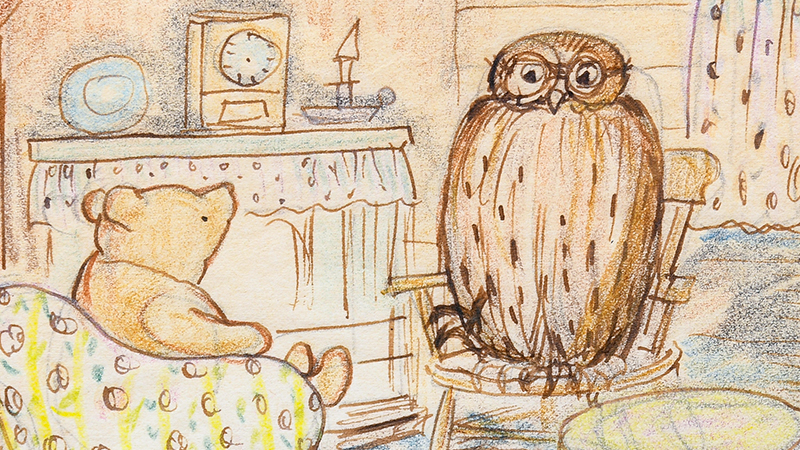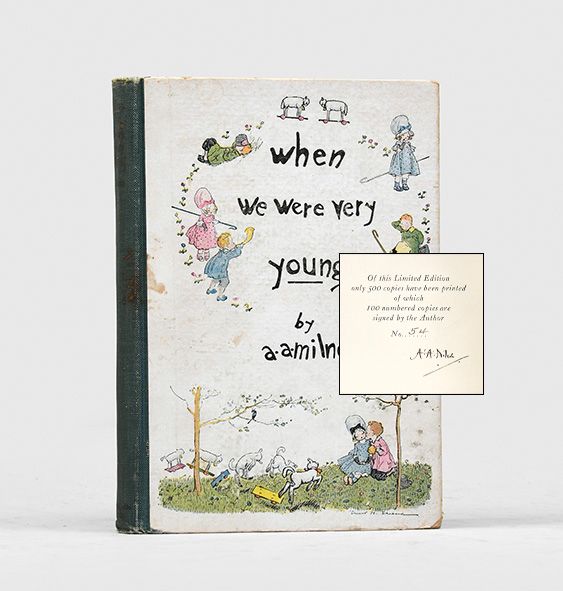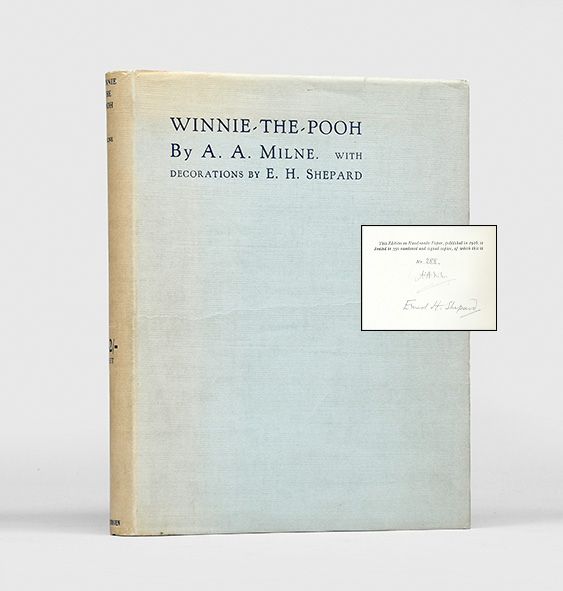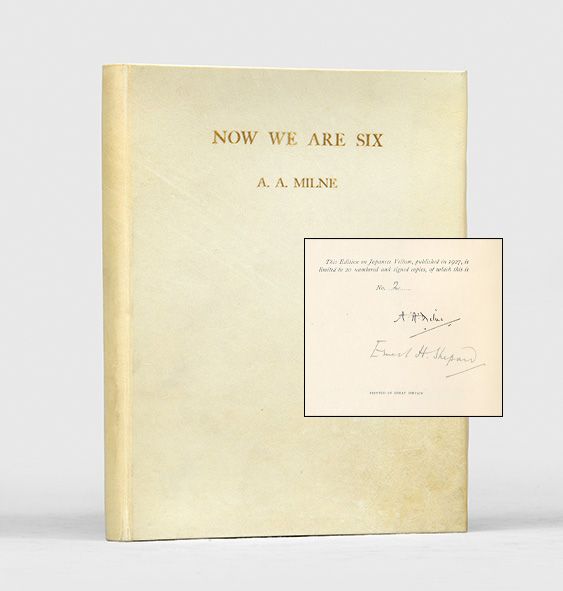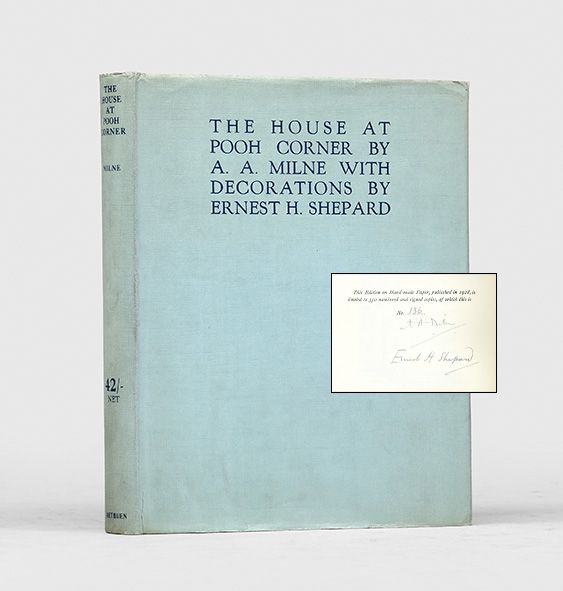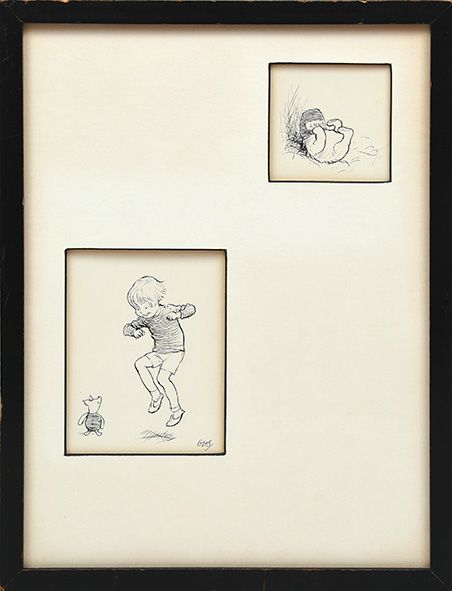Whether you like your Winnie-the-Pooh in the original A. A. Milne books or in a Walt Disney cartoon, or both, there’s no escaping the most famous teddy bear in the world. With the made-for-television cartoon series, The New Adventures of Winnie-the-Pooh, first broadcast in 1988, Pooh became a more popular character than Mickey Mouse for Disney. At Peter Harrington, the original books are exceptionally popular, and we have the privilege of offering some significant Milne or Shepard material.
Bears at the Beginning
Pooh’s story has two bear beginnings. During the First World War, a Canadian soldier brought a female bear cub with him to England from Winnipeg. Winnie eventually lived in London Zoo from 1914 until her death in 1934. It was there that Christopher Milne, the author’s son, made an ursine acquaintance. The other bear was a teddy bear bought for Christopher on his first birthday. Real and toy bears combined in A. A. Milne’s imagination and, crucially, E. H. Shepard’s artwork. The first of Milne’s verses for children, ‘Vespers’, was published in 1923. When Shepard came to illustrate it, there’s a familiar teddy bear at the foot of Christopher Robin’s bed.
When We Were Very Young
Published on 6 November 1924, the first book, When We Were Very Young, is a collection of verses including ‘Buckingham Palace’, ‘The King’s Breakfast’, ‘Halfway Down’, and ‘Vespers’. Many of these are familiar from their musical settings: famously Ann Stephens’s rendition of ‘Buckingham Palace’, and ‘Halfway Down the Stairs’ sung by Robin the Frog (Kermit’s nephew). Shepard’s illustration for ‘Halfway Down’ has Pooh bear at the top of the stairs and the original dust jacket for the book features him on the front panel. There was a standard trade edition and a signed limited edition (100 copies) published by Methuen in the UK. In the US, the Milne books were published by Dutton.
When We Were Very Young
Published on 6 November 1924, the first book, When We Were Very Young, is a collection of verses including ‘Buckingham Palace’, ‘The King’s Breakfast’, ‘Halfway Down’, and ‘Vespers’. Many of these are familiar from their musical settings: famously Ann Stephens’s rendition of ‘Buckingham Palace’, and ‘Halfway Down the Stairs’ sung by Robin the Frog (Kermit’s nephew). Shepard’s illustration for ‘Halfway Down’ has Pooh bear at the top of the stairs and the original dust jacket for the book features him on the front panel. There was a standard trade edition and a signed limited edition (100 copies) published by Methuen in the UK. In the US, the Milne books were published by Dutton.
Winnie-the-Pooh
The stories started when, in December 1925, Milne was asked to contribute a tale to the Christmas Eve issue of The Evening News. The story of Pooh climbing a tree to steal honey from some bees was also broadcast on the radio on Christmas Day. Winnie-the-Pooh had arrived, and a full book of adventures was published on 14 October 1926 by Methuen in the UK. It is an indication of the publisher’s faith in the new book that it was first published in three different versions: the standard trade edition, the signed limited edition (350 copies), and the signed extra limited edition (20 copies).
Winnie-the-Pooh
The stories started when, in December 1925, Milne was asked to contribute a tale to the Christmas Eve issue of The Evening News. The story of Pooh climbing a tree to steal honey from some bees was also broadcast on the radio on Christmas Day. Winnie-the-Pooh had arrived, and a full book of adventures was published on 14 October 1926 by Methuen in the UK. It is an indication of the publisher’s faith in the new book that it was first published in three different versions: the standard trade edition, the signed limited edition (350 copies), and the signed extra limited edition (20 copies).
Now We Are Six
For the third book in the series, Now We Are Six, Milne returned to verse. Publication date was 13 October 1927. Winnie-the-Pooh was now firmly established, and Shepard included him in many of his illustrations. When Christopher Robin meets a charcoal-burner, for example, there are three illustrations and Pooh is present in all. There is also the five stanza poem, ‘Us Two’, which commences “Wherever I am, there’s always Pooh, | There’s always Pooh and Me”. Shepard concludes this poem with another illustration of that famous staircase complete with bear. Once again, the English publishers issued a standard trade edition, a signed limited edition (200 copies), and a signed extra limited edition (20 copies).
Now We Are Six
For the third book in the series, Now We Are Six, Milne returned to verse. Publication date was 13 October 1927. Winnie-the-Pooh was now firmly established, and Shepard included him in many of his illustrations. When Christopher Robin meets a charcoal-burner, for example, there are three illustrations and Pooh is present in all. There is also the five stanza poem, ‘Us Two’, which commences “Wherever I am, there’s always Pooh, | There’s always Pooh and Me”. Shepard concludes this poem with another illustration of that famous staircase complete with bear. Once again, the English publishers issued a standard trade edition, a signed limited edition (200 copies), and a signed extra limited edition (20 copies).
The House at Pooh Corner
Despite the assurance in ‘Us Two’ that “two can stick together”, it’s the second story book and fourth volume in the series, The House at Pooh Corner, in which Christopher Robin and Pooh “come to an enchanted place, and we leave them there”. It’s one of the saddest episodes in children’s literature when we confront the truth that in growing up the child will spend less time with his beloved bear. Before this conclusion, however, there are the tales which feature a new character: Tigger. It’s a surprise that one of the most popular inhabitants of the Hundred Acre Wood is such a late appearance. He bounces off the page, however, and becomes one of Milne’s most beloved characters. By now the publishers knew they had a hit on their hands and on 11 October 1928, in addition to the standard trade edition, a signed limited edition (back to 350 copies), and a signed extra limited edition (20 copies) were published.
The House at Pooh Corner
Despite the assurance in ‘Us Two’ that “two can stick together”, it’s the second story book and fourth volume in the series, The House at Pooh Corner, in which Christopher Robin and Pooh “come to an enchanted place, and we leave them there”. It’s one of the saddest episodes in children’s literature when we confront the truth that in growing up the child will spend less time with his beloved bear. Before this conclusion, however, there are the tales which feature a new character: Tigger. It’s a surprise that one of the most popular inhabitants of the Hundred Acre Wood is such a late appearance. He bounces off the page, however, and becomes one of Milne’s most beloved characters. By now the publishers knew they had a hit on their hands and on 11 October 1928, in addition to the standard trade edition, a signed limited edition (back to 350 copies), and a signed extra limited edition (20 copies) were published.
Deluxe Bindings
It’s worth noting that Methuen also sold a deluxe binding of the trade issue of all the books (although the deluxe binding of When We Were Very Young only appears from the seventh impression). In contrast with a cloth binding dust jacket published at 7/6, the deluxe bindings in calf came with a thin tissue jacket in a box at 10/6.
A Winning Collaboration
It is true that Milne’s texts are inexorably linked to Shepard’s illustrations. E. H. Shepard was a well-respected artist working for Punch when he was asked to illustrate Milne’s work. His standard practice was to create a preliminary drawing in pencil. Having revised this, Shepard would then cover the reverse of the sheet with pencil shading. Placed on top of a sheet of artist’s board, he would then copy the drawing by tracing the appropriate lines of the composition. With a faint pencil outline, Shepard would then draw the finished illustration in black ink. The preliminary pencil sketches were retained by Shepard and throughout his life he would occasionally produce new drawings from them. The preliminaries are now in the Victoria and Albert Museum. The original ink drawings, once used by the publishers, were returned to Shepard and sold through a series of exhibitions at The Sporting Galleries in Covent Garden. It is because of these exhibitions that it is still possible to acquire Shepard’s original drawings, as published in the four Pooh books.
A Winning Collaboration
It is true that Milne’s texts are inexorably linked to Shepard’s illustrations. E. H. Shepard was a well-respected artist working for Punch when he was asked to illustrate Milne’s work. His standard practice was to create a preliminary drawing in pencil. Having revised this, Shepard would then cover the reverse of the sheet with pencil shading. Placed on top of a sheet of artist’s board, he would then copy the drawing by tracing the appropriate lines of the composition. With a faint pencil outline, Shepard would then draw the finished illustration in black ink. The preliminary pencil sketches were retained by Shepard and throughout his life he would occasionally produce new drawings from them. The preliminaries are now in the Victoria and Albert Museum. The original ink drawings, once used by the publishers, were returned to Shepard and sold through a series of exhibitions at The Sporting Galleries in Covent Garden. It is because of these exhibitions that it is still possible to acquire Shepard’s original drawings, as published in the four Pooh books.
An Excellent Reference Collection
One of the finest private collections of Milne and Shepard material was handled by Peter Harrington in 2011. Pat McInally (b. 1953), the distinguished former American football player and children’s book collector, assembled a magnificent collection over two decades. Our catalogue is still available as a wonderful source of reference of Milne and Shepard’s work, including a limited edition signed by Pat.
An Excellent Reference Collection
One of the finest private collections of Milne and Shepard material was handled by Peter Harrington in 2011. Pat McInally (b. 1953), the distinguished former American football player and children’s book collector, assembled a magnificent collection over two decades. Our catalogue is still available as a wonderful source of reference of Milne and Shepard’s work, including a limited edition signed by Pat.
Written by Dr Phil Errington, Senior Specialist

